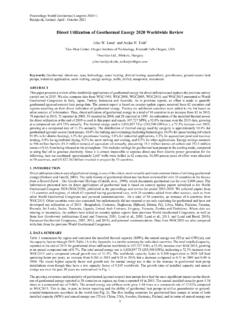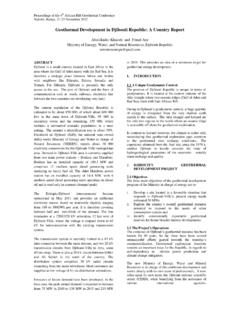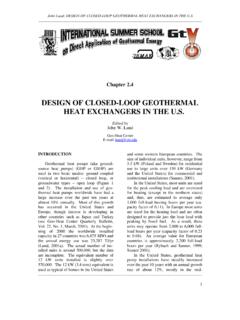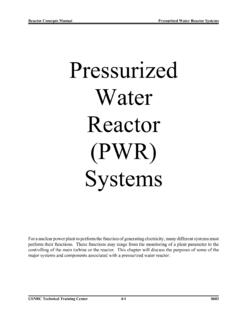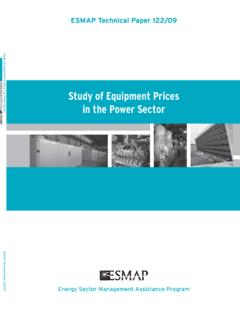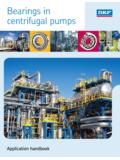Transcription of EFFICIENCY OF GEOTHERMAL POWER PLANTS: A …
1 1 New Zealand GEOTHERMAL Workshop 2012 Proceedings 19 - 21 November 2012 Auckland, New Zealand EFFICIENCY OF GEOTHERMAL POWER plants : a worldwide REVIEW Hyungsul Moon and Sadiq J. Zarrouk* Department of Engineering Science, University of Auckland, New Zealand Keywords: GEOTHERMAL POWER plants , conversion EFFICIENCY . ABSTRACT The conversion EFFICIENCY of GEOTHERMAL POWER developments is generally lower than that of conventional thermal POWER plants . Confusion can be found in literature concerning the estimation of this conversion EFFICIENCY . GEOTHERMAL POWER plants conversion EFFICIENCY estimates that is based on the enthalpy of the produced GEOTHERMAL fluid can be the most desirable for use during the first estimates of POWER potential of new wells and for resource estimation studies.
2 The overall conversion EFFICIENCY is affected by many parameters including the POWER plant design (single or double flash, triple flash, dry steam, binary, or hybrid system), size, gas content, parasitic load, ambient conditions, and others. This work is a worldwide review using published data from 94 GEOTHERMAL plants (6 dry-steam, 34 single flash, 18 double flash, 31 binary, 2 hybrid steam-binary and 1 triple flash plants ) to find conversion efficiencies based on the reservoir enthalpy. The highest reported conversion EFFICIENCY is approximately 21% at the Darajat vapour-dominated system, with a worldwide EFFICIENCY average of around 12%. The use of binary plants in low-enthalpy resources has allowed the use of energy from fluid with enthalpy as low as 306 kJ/kg, resulting in a net conversion EFFICIENCY of about 1%.
3 A generic GEOTHERMAL POWER conversion relation was developed based on the total produced enthalpy. Three additional, more specific, relationships are presented for single flash / dry steam plants , double flash plants , and binary plants . The conversion EFFICIENCY of binary plants has the lowest confidence, mainly because of the use of air cooling, which is highly affected by location and seasonal changes in ambient temperature. 1. INTRODUCTION GEOTHERMAL POWER development is witnessing a rapid growth worldwide . The short-term forecast indicates an installed capacity of 18,500 MWe by the year 2015. This represents an increase of approximately 73% from that of 2010 [1 ]. Figure 1: World GEOTHERMAL POWER plant installed capacity (data from [1]) The conversion EFFICIENCY is of significant importance when calculating the POWER potential of newly drilled GEOTHERMAL wells and for resource estimation studies.
4 The conversion EFFICIENCY is the ratio of net electric POWER generated (MWe) to the GEOTHERMAL heat produced/extracted from the reservoir (MWth). GEOTHERMAL POWER plants have lower EFFICIENCY relative to other thermal POWER plants , such as coal, natural gas, oil, and nuclear POWER stations (Figure 2). Figure 2: Thermal POWER Plant EFFICIENCY (data from [2-3 ] this work*) It is commonly assumed that only 10% of the energy from the produced GEOTHERMAL fluid can be converted to electricity [4 ]. Another study suggests that the POWER conversion EFFICIENCY from GEOTHERMAL steam ranges from 10 to 17% [5 ]. However, each GEOTHERMAL POWER plant has its own conversion EFFICIENCY . For example, Chena Hot Springs [6, 7] binary plant has an EFFICIENCY of only 1% due to an average fluid enthalpy of 306 and a temperature of 73 C, while Darajat [8, 9] in Indonesia reaches an EFFICIENCY of For resource estimation, the AGEA (2010) gave preference to using a specified process/technology rather than using an EFFICIENCY of conversion based on the energy removed.
5 This study reviews the efficiencies of GEOTHERMAL POWER plants based on the type of plant and the features of the GEOTHERMAL fluid. The EFFICIENCY of a POWER station is evaluated as follows: net electricity produced/energy input [9]. In GEOTHERMAL POWER plants , the energy input can be defined as total mass of fluid (kg/s) multiplied by the average enthalpy (kJ/kg) as shown below: act (%) = W h 100 (1) where W is the running capacity (kWe), is the total mass flow rate (kg/s), and h is the reservoir enthalpy (kJ/kg). This work provides a high-level assessment of the conversion EFFICIENCY of GEOTHERMAL POWER plants based on available data from the current worldwide experience.
6 2. FACTORS AFFECTING EFFICIENCY When GEOTHERMAL fluid is extracted from a production well, it passes through many processes and/or different pieces of equipment on its way to the POWER station. During this time 270 520 1180 4764 6833 8933 10715 18500 0500010000150002000019551965197519851995 200520102015 MWe Time (years) 01020304050 GeothermalPower Station*Coal FiredPower StationNatural FiredGas PowerStationOil Fired PowerStationNuclear PowerStation EFFICIENCY (%) 2 New Zealand GEOTHERMAL Workshop 2012 Proceedings 19 - 21 November 2012 Auckland, New Zealand the GEOTHERMAL fluid loses energy that is not used to produce POWER . In liquid dominated systems, the produced two-phase GEOTHERMAL fluid loses a significant amount of heat when separating steam from water, because only the separated steam is used for generation unless there is another separator or binary plant installed.
7 For example, the Kizildere [10, 11] single flash plant uses GEOTHERMAL fluid with an enthalpy of 875 kJ/kg. Therefore, only 36% of the heat from the separator is sent to the turbine. While, for high enthalpy GEOTHERMAL fluid will have more of the produced heat will be sent to the POWER station. An example of this is the Nesjavellir plant, which has an enthalpy of 1503 kJ/kg where 66% of heat reaches the turbine, while the plants at Cerro Prieto and Svartsengi have respective enthalpies of 1396 and 1148 kJ/kg receives 68 and 70% respectively. Double flash and/or bottoming binary plants can use heat more effectively. However, during the design of the separator, the main consideration is the silica (SiO2) content of the GEOTHERMAL fluid.
8 During the flash process, a pressure drop is used to generate additional steam from the GEOTHERMAL fluid. This results in an increase in the silica concentration of the remaining fluid (brine). This silica can build up a layer of solid deposit on the internal surfaces of pipelines, flash plants and turbines, impeding the flow of the fluid and leading to a drop in conversion EFFICIENCY and high maintenance cost. Other factors affecting the conversion EFFICIENCY are: Non-condensable gas (NCG) content, heat loss from equipment, turbine and generator EFFICIENCY and POWER plant parasitic load ( fans, pumps, and gas extraction system) [12-17]. The presence of NCG has no major negative impact until the steam reaches the condenser [18].
9 GEOTHERMAL fluid the contains NCG s lowers the POWER EFFICIENCY because it decreases the specific expansion work in the turbine and has adverse effect on the performance of a turbine [19, 20]. Kizildere [16] field s average non-condensable gases percentage is 13% by weight, meaning that the POWER consumption of the gas extraction system is comparatively high. An NCG content of 1% by weight reduces the POWER out by in comparison with steam without NCG [21]. ncg= 1 (2) where C is the NCG content % by weight. Cooling the steam as it leaves the turbine is necessary in order to raise the POWER conversion EFFICIENCY . Cooling the water for the condenser requires pumps and fans.
10 A dry type cooling tower consumes twice as much electricity [22]. Also some GEOTHERMAL plants use production pumps as well as reinjection pumps. Mutnovzky, Kamchatka [23] single flash plant turbine exhaust pressure is only bar abs. so the heat used in turbine percentage is notably higher than the plants using similar enthalpy GEOTHERMAL fluid in warmer environment. Auxiliary POWER consumption, which includes all pumps, cooling equipment, and gas extractors in a POWER plant is subtracted from the gross POWER output. apc= 1 WapcWgross (3) where Wgross is the gross electric POWER and Wapc is the total auxiliary POWER consumption. GEOTHERMAL fluid also loses heat in pipes, with the size of the losses depending on the pipe insulator, the length of pipe, and the ambient temperature.
